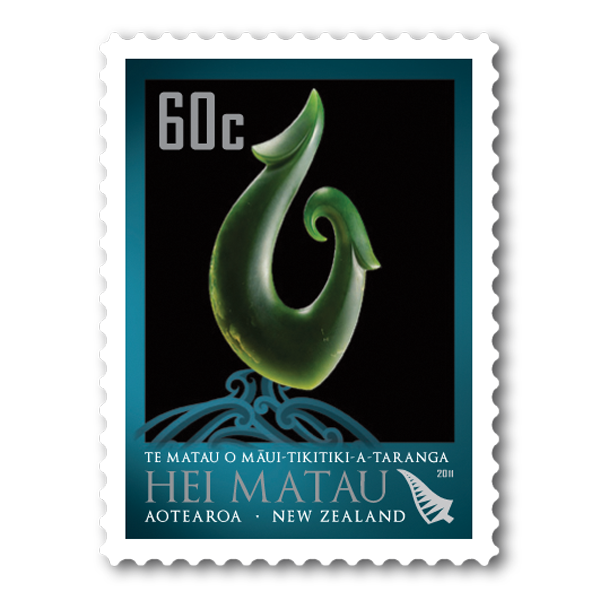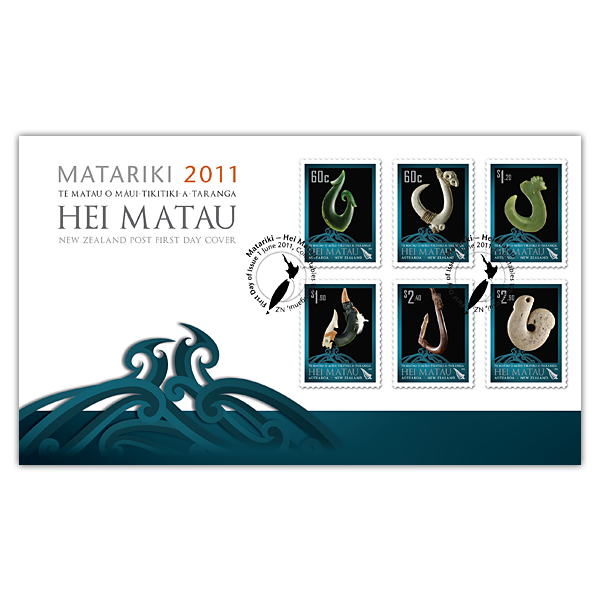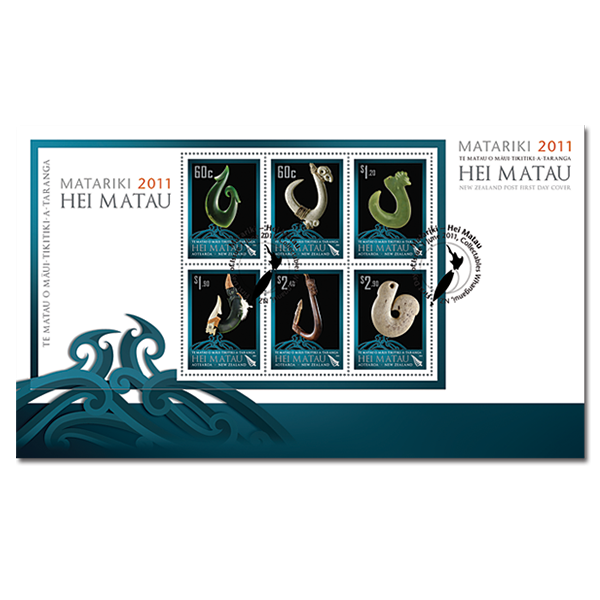The appearance of the star cluster known as Matariki is a time to celebrate New Zealand's unique history and place in the world. New Zealand Post marked the start of the Māori New Year with its Matariki 2011 - Hei Matau stamp issue.
Issue information
Meaning 'fish hook', matau are traditionally an important aspect of Māori life, providing Māori with the means to catch their kai moana or 'food from the sea'. Many fishermen had their own 'lucky' fish hook, which they would wear around their necks (hei matau) for safekeeping.
Today hei matau are used less for catching fish and more for catching someone's eye when worn as pendants. They remain a cultural treasure (taonga), and have an important link to the origins of Aotearoa, New Zealand. According to Māori legend, New Zealand's North Island was once a giant fish that was caught by the half-god and seafarer Māui, using a woven line and his magic bone matau.
Hei matau have a strong connection to Tangaroa, god of the sea, and as such the stamp products in this collection featured the common stylised element of the sea. Meaning 'the fish hook of Māui', the phrase 'Te matau o Māui-tikitiki-a-Taranga' has also been incorporated in the design.
Product Listing for Matariki 2011 - Hei Matau
| Image | Title | Description | Price |
|---|---|---|---|
 |
Single Stamp |
Single 60c 'Manaia' self-adhesive stamp. This hei matau dates from 1500 to 1800, is housed in The Museum of New Zealand - Te Papa Tongarewa, and is an example of a functional fish hook that might have hung around a fisherman's neck. Made from whalebone, it's elaborately carved with manaia (Māori spiritual guardian) faces at the apex of the shank and also at the bait-knob. The traditional hook shape is designed to cut into the fish's mouth. |
$0.60 |
 |
Single Stamp |
Single 60c 'Pounamu' self-adhesive stamp. This modern hei matau was handcrafted by Lewis Gardiner (Ngāti Pikiao, Ngāti Awa, Te Whānau-a-Apanui, Ngāi Tahu). Made from pounamu, it is representative of strength, abundance and provision. Commissioned specifically for this stamp issue, it is now a part of the New Zealand Post Collection. |
$0.60 |
 |
Single Stamp |
Single $1.20 'Inanga' self-adhesive stamp. This hei matau dates from around 1800, and is also housed in Te Papa Tongarewa. Sourced from Westland in the South Island, it is made from inanga (milky white) pounamu. The elaboratively carved crown is entirely decorative, and the barb point has also been decorated with delicate notching. |
$1.20 |
 |
Single Stamp |
Single $1.90 'Te Puia' self-adhesive stamp. This hei matau was crafted for this stamp issue by Te Puia, the New Zealand Māori Arts and Crafts Institute. Made by Lewis Gardiner, Head of the National Bone, Stone and Greenstone Carving School, it was based on the traditional pā kahawai, i.e. made from multiple materials and lashed together. Pounamu, whalebone, feathers and muka (flax fibre) are used for the hook, while the eye inserts are made with paua. |
$1.90 |
 |
Single Stamp |
Single $2.40 'Pukengaki' self-Adhesive stamp. Housed in the Auckland War Memorial Museum (Tamaki Paenga Hira), this hei matau is made from wood and dates from around 1800. The wood was trained to grow into the shape of a fish hook, then carved and combined with an unusually large bone barb designed to hook the fish’s mouth securely. The top of the hook features an intricately carved manaia face. |
$2.40 |
 |
Single Stamp |
Single $2.90 'Tohorā' self-adhesive stamp. Also housed in Te Papa Tongarewa, this hei matau dates from 1750 to 1850. It is a classic symbolic representation of the fish hook used by the Polynesian cultural hero Māui. Made from whalebone, some say its shape is designed to wedge in the fish’s mouth rather than hook it. |
$2.90 |
 |
Miniature Sheet | Mint, used or cancelled gummed miniature sheet. | $9.60 |
 |
First Day Cover | First day cover with six self-adhesive stamps affixed. | $10.10 |
 |
Miniature Sheet First Day Cover | First day cover with gummed miniature sheet affixed. | $10.10 |
 |
Presentation Pack | Presentation pack which featured a strip of six self-adhesive stamps, the first day cover and the gummed miniature sheet. It also tells the legend of the great fish of Maui, written by Ross Calman especially for this stamp issue. | $29.90 |
 |
Limited Edition | Limited edition which contained exclusive stamp products including a booklet with a block of six of each of the stamps. Also included are six self-adhesive stamps, a numbered imperforate miniature sheet, a souvenir first day cover and colour separations of the $2.90 stamp. | $135.00 |
Technical information
| Date of issue: | 1 June 2011 |
|---|---|
| Number of stamps: | Six self-adhesive stamps |
| Miniature sheet: | One sheet with six gummed stamps |
| Denominations: | 60c (x2), $1.20, $1.90, $2.40 and $2.90 |
| Stamps and first day cover designed by: | Len Hetet, Whakatane, New Zealand |
| Printer and process: | Southern Colour Print Ltd by offset lithography |
| Number of colours: | Four process colours |
| Stamp size and format: | 40mm x 30mm (vertical) |
| Paper type: | Self-adhesive: Tullis Russell PSA red phosphor stamp paper 220gsm; Gummed miniature sheets: Tullis Russell 104gsm red phosphor gummed stamp paper |
| Number of stamps per sheet: | 25 stamps |
| Perforation gauge: | Gummed: 13.33 x 13.60; Self-adhesive: die-cut |
| Special blocks: | Plate/Imprint blocks were obtained by purchasing at least six stamps from a sheet. Barcode blocks were available in A and B formats. |
| Period of sale: | These stamps remained on sale until 31 May 2012. |

